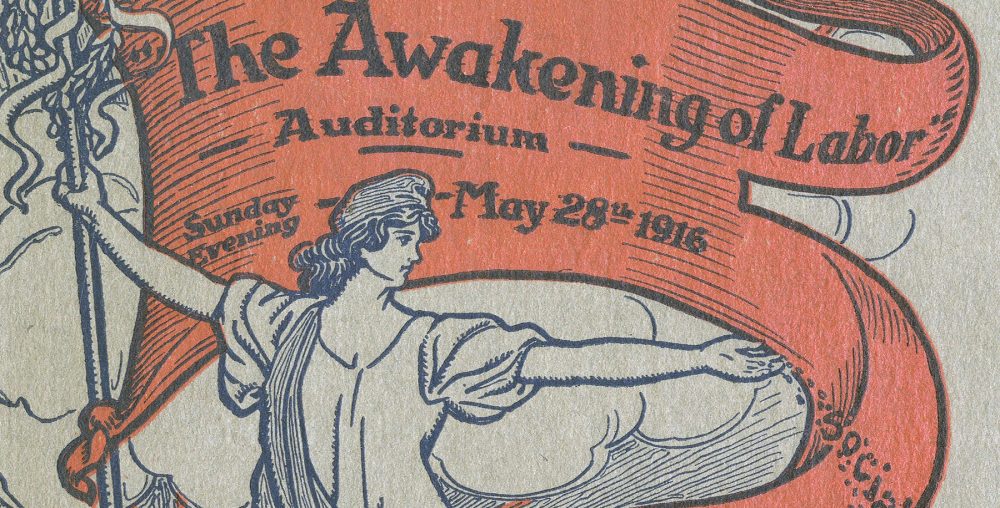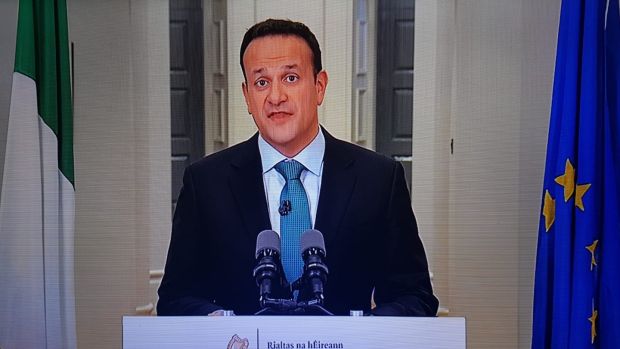 The advice from the health experts of the National Public Health Emergency Team (NPHET) was that it was necessary to move from level 2/3 to level 5 because this was the “only opportunity” to get Covid-19 “back under control”. But when this was rejected by the government and Leo Varadkar went on TV to cut the Chief Medical Officer (CMO) off at the knees, he damned not only the CMO and his advice but also the strategy of his Government.
The advice from the health experts of the National Public Health Emergency Team (NPHET) was that it was necessary to move from level 2/3 to level 5 because this was the “only opportunity” to get Covid-19 “back under control”. But when this was rejected by the government and Leo Varadkar went on TV to cut the Chief Medical Officer (CMO) off at the knees, he damned not only the CMO and his advice but also the strategy of his Government.
Not only could it no longer be claimed that government strategy was the product of expert advice, but it raised the obvious question why total lockdown was previously implemented. If it was necessary in March there was no reason it wasn’t necessary now. Where is the improvement in the test and trace system and health service capacity over the summer that might have been presented as some sort of explanation for a more relaxed policy now?
All the questions raised in my previous post could be asked again, including how the different levels of intervention make any sense when, for example, the criteria that are supposed to prompt intervention are the same for levels 2 to 4. In the previous post the question was where was level 2 and a half, or 3 and a bit, applied to Dublin? Now it is – what are all these levels for in the first place?
There are of course real concerns, such as the reported “sustained increase” in cases among the elderly with seven new outbreaks in nursing homes in the previous week, especially when we recall that over half the deaths have come from these facilities. But this too raises a question – if lockdown didn’t prevent these deaths then, what would lead us to believe it would do so now? After all, we have been told that to protect the vulnerable we have to have complete lockdown but it didn’t work before – why not?
And if the NPHET is the while knight alternative to the Government – where have the warnings been about the preparedness of the health service and the vulnerability of the old and special measures proposed to protect them?
Instead we have a lower level of restrictions, although still based on the same assumption that everyone must be isolated in order to also protect the vulnerable. To present a show of real intent thousands of Garda, at hundreds of road blocks, have attempted to prevent the whole population from moving outside their county (as if these were epidemiologically significant boundaries) in order to deliberately gum up traffic, when such movement is entirely legal.
Apparently Varadkar had some tough questions for CMO Tony Holohan, like what was the metric for success and how long would the lockdown last? There has even been speculation of following the widely trailed policy supposedly to be implemented in the North – a ‘circuit breaker’, i.e. a relatively short lockdown to bring the virus ‘back under control’. But this can’t explain why a shorter repeat of the last lockdown will not result in the same increase in the virus when it ends.
Unless, of course, as I noted in the last post, the spread of Covid is much greater than reported, in which case the rationale for lockdown is even more undermined.
Varadkar also apparently said to the Chief Medical Officer that Ireland needed a plan in case this one didn’t work and a plan for re-opening if it does, and a plan for communications as well. A bit rich coming from Varadkar you might think, since if we work our way backwards on this list, the Government screws up communications each time it attempts to communicate; a plan for re-opening should already be in place since we have already had a re-opening; and we should also have a plan from the Government if lockdown doesn’t work since we have had a lockdown and it didn’t work.
Which neatly brings us to the need for an alternative. As in the previous post, we can briefly review what has been proposed by some of the left, by People before Profit (PbP), which has beefed up its press statements and explained a little more about its zero-Covid policy. This it seems “does not mean we reach absolute zero in terms of cases. It means crushing the virus to the point where we can test, trace and isolate every single case that arises, stopping the spread of the virus.”
But if up to 30% of positive cases show up as negative then it is impossible to “test, trace and isolate every single case.” Never mind the prior problem that, as The Guardian newspaper reports, “researchers at UCL said 86.1% of infected people picked up by the Office for National Statistics Covid-19 survey between April and June had none of the main symptoms of the illness, namely a cough, or a fever, or a loss of taste or smell the day they had the test. Three quarters who tested positive had no notable symptoms at all.”
The proposals by PbP support level 5 lockdown and include expansion of testing and tracing and health services; increased workplace inspections and more money spent on teachers with the potential for closure of schools “until the virus is crushed.” Inexplicably, there is no specific mention of those most at risk. Nothing is said about how long this lockdown would have to last and what the financial cost would be. Nothing, in other words, about the deaths and illness caused by prolonged isolation, a health service diverted from its day job or the long-term effects of a prolonged lockdown.
There is also nothing on the level of State coercion that would be required to impose a more severe lockdown with an indefinite timescale. People before Profit is kidding itself if it believes that this would not be required.
It calls for a harmonised response across the island but the problem isn’t harmonisation, it’s that both jurisdictions are making the same mistakes. To little public response the Health Minister in the North reported that there was, after all, to be no announcement on plans for the NHS to return to normal operation – how and when it will return to delivering all the health and social care that consume more lives but are not now so politically prominent. There was a time when Sinn Fein complained of political policing, but now it is in office we have the previously undreamed problem of political health care.
The Guardian has another article ‘Why herd immunity strategy is regarded as fringe viewpoint’ that criticises a strategy focused on protecting the most vulnerable, those at most risk. Unfortunately it ignores the failure of the current strategy in Britain, which is due not simply to Tory mendacity and incompetence.
The alternative is damned for being outside the ‘scientific mainstream’ and having extreme right-wing supporters, neither of which proves anything more than these bald facts. It quotes one professor who ‘is among many scientists who are sceptical that the most vulnerable in society can be adequately identified and protected. “It is a very bad idea,” he said. “We saw that even with intensive lockdowns in place, there was a huge excess death toll, with the elderly bearing the brunt of that.” In the UK, about a quarter of the population would be classed as vulnerable to Covid-19.”
This is stated almost as if 25% is too great a number to protect. So let’s go for 100%? They can’t be adequately identified and protected? So why can’t the health service and social services be mobilised to identify them from its records and then put in place measures to support and protect them? Why would it be a problem, for example, to identify everyone in elderly person’s homes? Or receiving treatment for those underlying conditions that make them vulnerable? Even the first measure might have made a major contribution to protecting half of people who died but were supposedly being protected by measures aimed at everyone else.
And let’s not forget that primary among that to be protected was the health service itself. As I’ve pointed out before – isn’t it supposed to protect us?
Another biostatistician is quoted as saying that actually this strategy of protecting the vulnerable was tried – “Shielding of the vulnerable was part of the UK policy since the start of lockdown.” Except of course, this was never true, not in Britain and not in Ireland either, as the irresponsible transfer of the elderly out of hospital and into homes with their lack of PPE testing and adequate staffing amply demonstrated. To claim otherwise is to admit the existing strategy had to entail these deaths – not something you will hear or read very often.
“What troubles many scientists is that with coronavirus no one knows how protected people are after contracting the virus, how long that protection lasts, and exactly what proportion of society needs to be immune to quell a pandemic.” All good questions, none of which provide support for the existing strategy or damn the alternative; or address the fact that the relatively young and those without the relevant underlying conditions have little to worry about. These concerns apply equally to a vaccine, but no one will advance them as objections to vaccination.
“It is impossible to fully identify who is vulnerable and it is not possible to fully protect them.” But is it harder to protect them than to fully protect everyone?
‘Another concern many scientists raise is the impact on the young and healthy. While the risk of death is low in people under 40, infection can still expose them to long-term complications that healthcare could be left dealing with for decades . . . “Quite large numbers of younger people are already becoming infected at present, whether or not they are being encouraged, and there are consequences to those infections.”
There do indeed seem to be some consequences for some younger people but transparency on this, how many there are and what the effects are, is not readily available. But it is not possible to put this into perspective with a strategy that is based on treating the whole population as if it was under the same threat. Identifying exactly who is at risk and of what is not what the current approach is about, and scare stories and sensationalist reporting are instead the order of the day.
If socialism is about building a counter-power within capitalism that fights for its replacement this must include the development of the organisation and consciousness of the working class, starting with its labour movement. This organisation must include scientific bodies and scientific consciousness. We don’t have working class scientific organisations – bodies consisting of scientific professionals belonging to or sympathetic to the labour movement or socialism – but the Covid-19 pandemic is one more lesson that we cannot afford to accept that the state, in its welfare guise or not, will provide the protection or support we need.
Beyond the arguments over the failure of almost all capitalist states to protect its most vulnerable, and the strategies that would most successfully address this need, lies this longer term task that the labour movement and socialists must accept and seek to address now and after the pandemic is over.

 Just over a month ago my wife and I visited my daughter, her boyfriend, and my sister in Glasgow and had dinner in my sister’s house. Two weeks later this would not have been possible, I would have been breaking the Covid regulations; in fact, my daughter and sister couldn’t have done it together even without us. They could, however, have met together in the pub, which of course doesn’t make much sense, as this
Just over a month ago my wife and I visited my daughter, her boyfriend, and my sister in Glasgow and had dinner in my sister’s house. Two weeks later this would not have been possible, I would have been breaking the Covid regulations; in fact, my daughter and sister couldn’t have done it together even without us. They could, however, have met together in the pub, which of course doesn’t make much sense, as this 

 The first graph shows that there are increased numbers of cases in a number of countries giving rise to the concern about a resurgence. The second graph however puts this into perspective, that growth in the cumulative number of cases is not at all as high as it was initially or in the first 50 to 100 days.
The first graph shows that there are increased numbers of cases in a number of countries giving rise to the concern about a resurgence. The second graph however puts this into perspective, that growth in the cumulative number of cases is not at all as high as it was initially or in the first 50 to 100 days.

 I watched the BBC Panorama programme on the NHS and the Government failure to prepare properly for the Covid-19 pandemic, despite warnings. It focused on its failure to stock and resupply adequate amounts of appropriate Personal Protection Equipment, and to spin the amount of PPE newly received by, for example, counting a pair of gloves as two items and including cleaning disposables as equipment.
I watched the BBC Panorama programme on the NHS and the Government failure to prepare properly for the Covid-19 pandemic, despite warnings. It focused on its failure to stock and resupply adequate amounts of appropriate Personal Protection Equipment, and to spin the amount of PPE newly received by, for example, counting a pair of gloves as two items and including cleaning disposables as equipment. The British Government’s approach to the Coronavirus has been the subject of much, almost smug, criticism on this side of the Irish Sea. In the North nationalists, and not only they, have called for an all-island approach and rejection of the British strategy of ‘herd immunity’. Every British failure has been criticised and the response of the Irish Government lauded.
The British Government’s approach to the Coronavirus has been the subject of much, almost smug, criticism on this side of the Irish Sea. In the North nationalists, and not only they, have called for an all-island approach and rejection of the British strategy of ‘herd immunity’. Every British failure has been criticised and the response of the Irish Government lauded. In my previous
In my previous 
